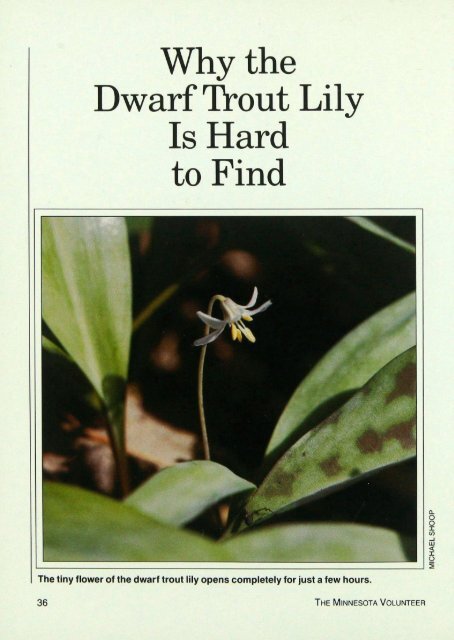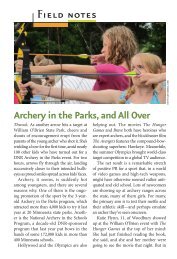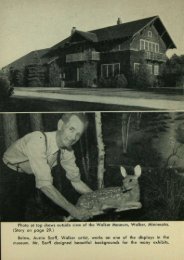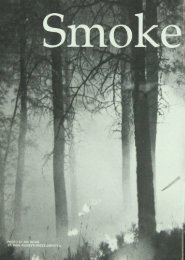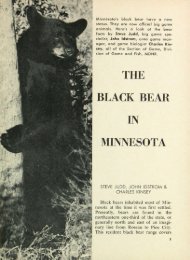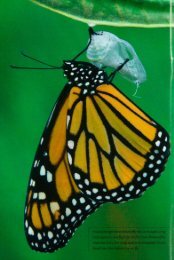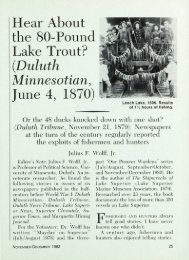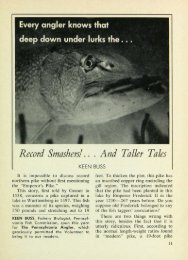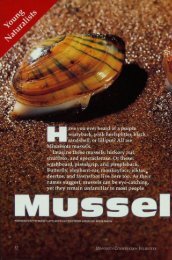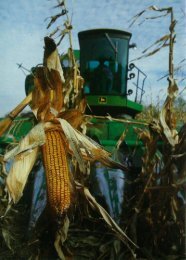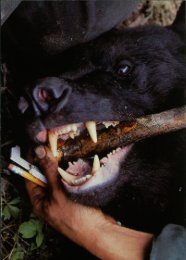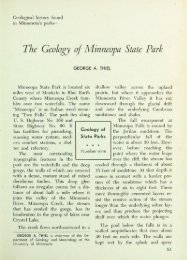1906 Why the Dwarf Trout Lily Is Hard to Find - webapps8
1906 Why the Dwarf Trout Lily Is Hard to Find - webapps8
1906 Why the Dwarf Trout Lily Is Hard to Find - webapps8
- No tags were found...
Create successful ePaper yourself
Turn your PDF publications into a flip-book with our unique Google optimized e-Paper software.
<strong>Why</strong> <strong>the</strong><strong>Dwarf</strong> <strong>Trout</strong> <strong>Lily</strong><strong>Is</strong> <strong>Hard</strong><strong>to</strong> <strong>Find</strong>I The tiny flower of <strong>the</strong> dwarf trout lily opens completely for just a few hours.36 THE MINNESOTA VOLUNTEER
The dwarf trout lily occursnaturally in Minnesota andnowhere else in <strong>the</strong> world.Survival of this rarewildflower is in questionON A SPRING day in 1870, MaryHedges, a botany teacher at St.Mary's School in Faribault, Minn.,came upon an unusual, diminutive lilygrowing on <strong>the</strong> banks of <strong>the</strong> StraightRiver. A specimen was sent <strong>to</strong> AsaGray, a botanist at Harvard University,who determined that it was a newspecies and named it Erythroniumpropullans. The tiny wildflowerbecame more commonly known as <strong>the</strong>dwarf trout lily, Minnesota trout lily,or dwarf dog-<strong>to</strong>o<strong>the</strong>d violet.Since it was first discovered, manybotanists have searched for o<strong>the</strong>r siteswhere <strong>the</strong> dwarf trout lily might grow.It has been found in only two countiesin sou<strong>the</strong>astern Minnesota and hasnever been found outside <strong>the</strong> state.In fact, it is Minnesota's only endemicwildflower—one that occurs naturallyhere and nowhere else.All known locations of dwarf troutlily arc found within a 275-square-milearea in Rice and Goodhue counties.Within this small area, roughly 600acres are suitable habitat for this troutlily.The lily most often grows on rich,Ellen Fugewell-aerated soil on wooded, northfacingslopes and on flood plains alongstreams or old stream channels. Amere 75 acres of this habitat areactually populated by this fragileflower. Because of its limited rangeDNR botanist Welby Smith examinesdwarf trout lilies growing in rich soil onwooded slope in one of few knownlocations of Minnesota's rare lilies.MARCH-APRIL 1989 37
Rare Wildflowerand small numbers, <strong>the</strong> dwarf troutlily was given endangered speciesstatus by <strong>the</strong> state of Minnesota in1984 and by <strong>the</strong> federal governmentin 1986.Habitat destruction is <strong>the</strong> greatestthreat <strong>to</strong> survival of <strong>the</strong> dwarf troutlily. Road construction, certain recreationalactivities, urban expansion,logging, and some agricultural practicesmay destroy or increase erosionand siltation of trout lily habitat.We are gradually learning moreabout this rare flower. The dwarf troutlily is one of many spring ephemerals—plantsthat complete <strong>the</strong>ir entirelife cycle during a few weeks in spring.This short cycle is an adaptation <strong>to</strong>living in deciduous forests—typicallysugar maple, basswood, cot<strong>to</strong>nwood,and soft maple—where plantson <strong>the</strong> forest floor must grow, flower,and set seed before leaves form ontrees and block sunlight. O<strong>the</strong>rephemerals sharing <strong>the</strong> forest floorwith <strong>the</strong> dwarf trout lily include Virginiawaterleaf, cleavers, springbeauty, and <strong>the</strong> common white troutlily.Look-Alikes. The dwarf trout lilyand <strong>the</strong> white trout lily look much likeeach o<strong>the</strong>r. They can best be distinguishedfrom each o<strong>the</strong>r when inflower. The flowers of <strong>the</strong> dwarf troutlily are smaller and pinker.Ellen Fuge is natural resource specialist,Natural Heritage Program, DNR Sectionof Wildlife, St. Paul.Fruits of <strong>the</strong> dwarf trout lily are alsosmaller and nod slightly on <strong>the</strong>ir stem.Fruits of <strong>the</strong> white trout lily areupright. The leaves of <strong>the</strong>se two similarspecies are about <strong>the</strong> same sizeand slightly mottled, but those of <strong>the</strong>dwarf trout lily tend <strong>to</strong> be narrowerand taper more gradually <strong>to</strong>ward <strong>the</strong>tip.Although <strong>the</strong> dwarf trout lily has arestricted range, it is typically foundwith <strong>the</strong> white trout lily, which isbroadly distributed. It has never beenfound with <strong>the</strong> yellow trout lily, alsofound in Minnesota.The dwarf trout lily may haveevolved from <strong>the</strong> white trout lily nomore than 9,000 years ago, after <strong>the</strong>last glaciers left Minnesota. A recentstudy by John Pleasants, botany professorat Iowa State University,showed that <strong>the</strong> dwarf trout lily has agenetic makeup similar <strong>to</strong> that of <strong>the</strong>white trout lily. The two trout liliesare able <strong>to</strong> crossbreed, producing ahybrid with intermediate physicalcharacteristics.Pleasants demonstrated that largepopulations of dwarf trout lilies arecomposed of genetically identicalindividuals or clones. This confirmedthat <strong>the</strong> predominant, and perhapsonly, means of reproduction in <strong>the</strong>dwarf trout lily is from runner bulbs.Pleasants identified only 21 genotypesof dwarf trout lily, illustratinglittle genetic diversity compared <strong>to</strong>that of <strong>the</strong> white trout lily and manyo<strong>the</strong>r flowering plants that reproducethrough seed production. However,this limited number of genetic38 THE MINNESOTA VOLUNTEER
As part of <strong>the</strong> DNR Natural Heritage Program's endangered species project, DNRworkers and volunteers map and take a census of dwarf trout lily populations.types of dwarf trout lily demonstratesthat at some time in <strong>the</strong> past geneticdiversity was achieved through seedproduction.Unusual Reproduction. The dwarftrout lily has several o<strong>the</strong>r characteristicsthat set it apart from o<strong>the</strong>r troutlilies and help explain why it is sucha rare and geographically restrictedplant. Unlike many flowering plants,<strong>the</strong> dwarf trout lily produces seedinfrequently, if at all.With support from <strong>the</strong> Minnesotachapter of <strong>the</strong> Nature Conservancy,JoAnne Banks, a graduate studentfrom La Crosse, Wis., spent twoseasons observing <strong>the</strong>se plants forpollina<strong>to</strong>rs. The minor bee was <strong>the</strong>most frequent pollina<strong>to</strong>r observedMARCH-APRIL 1989 39
DNR botanists visit dwarf trout lily site in Nerstrand Woods State Park eachspring <strong>to</strong> observe variations and patterns in <strong>the</strong> number of plants flowering.many plants bloomed <strong>the</strong> second year.This was a pleasant surprise, indicating<strong>the</strong> presence of more plants thanbotanists originally thought.Botanists will return <strong>to</strong> this site forseveral years <strong>to</strong> look for any variationor pattern in <strong>the</strong> number of plants thatflower each spring. From this research<strong>the</strong>y hope <strong>to</strong> learn if fluctuations inpopulations are natural phenomenonor indications of disturbances requiringmanagement action.The DNR Scientific and NaturalAreas Program assists <strong>the</strong> park inmanaging <strong>the</strong> Nerstrand Woods site.Rip-rap constructed on <strong>the</strong> banks ofa stream adjacent <strong>to</strong> <strong>the</strong> site reduceserosion, which threatened <strong>the</strong> lilypopulation. A boardwalk allows visi<strong>to</strong>rs<strong>to</strong> view <strong>the</strong> lilies without trampling<strong>the</strong>m.Research <strong>to</strong> develop an alternatemeans of propagation for <strong>the</strong> dwarftrout lily has been proposed by <strong>the</strong>Holden Arboretum in Cleveland,Ohio. The Holden Arboretum is amember of <strong>the</strong> Center for Plant Conservation,a private Massachusettsbasedfoundation promoting preservationof endangered plants.Using funds raised by <strong>the</strong> Minne<strong>to</strong>nkaGarden Club, <strong>the</strong> Center hopes<strong>to</strong> find ways <strong>to</strong> increase <strong>the</strong> numberof individual plants. These efforts willenhance <strong>the</strong> relatively slow rate ofreproduction in <strong>the</strong> wild and aid inmanagement and res<strong>to</strong>ration of thisrare species. •MARCH-APRIL 1989 41


